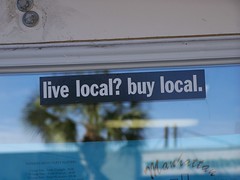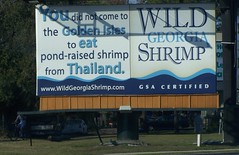Buying local

Sometimes I have a problem with buy local campaigns, because they are focused on the consumer--buy local--and a lot of the time such programs fail to acknowledge that it is incumbent on the local merchants to do a great job as well, to have something to offer. Retail is a two-way street, a transaction between retailers and customers has to provide benefit to both.
I always hated having to do Christmas promotions in commercial districts where there are few stores for shopping options for good gifts. Let's be real. Just like if you're not a sports bar and to promote the Super Bowl you bring in some more televisions. Mostly, people are going to go to the better place to watch a game on television or to shop. So we need to focus on making our places and stores better.
This is what the Reilly Law of Retail Gravitation is about, what I call the "hard side" of commercial district revitalization, having more and better stores. (It's a mathematical formula but comes down to having more stores, more choices.) With transportation costs being relatively equal, people choose to go to the place with more and better stores.
So when you aren't representing one of those places, and your stores aren't great, the commercial district is dirty, and the buildings aren't well-maintained (this is part of what I call the "soft side" of commercial district revitalization), well, it's tough to be a Main Street commercial district revitalization professional...
In that vein, Martin Dreiling, of Dreiling Terrones Architects, wrote this to members of his firm and he sent it to an e-list I am on (reprinted with permission).
-------------
Patronizing The Local Merchants
To all staff: Some basic DTA ideas for your consideration:
If you know all this that's great. Don't take it as condescending, presumptuous or critical in any way. Jake will pat you on the back and give you a big kiss. But if you think this is all bullshit, you're a looooooser !!!!
As proponents of localism we'd like to encourage everyone to avoid malls and national chain stores this season. Try, as much as you can, to shop local (or make things... with your own brains and hands.) Avoid catalogs and online purchases as these have incredible environmental impacts related to packaging, shipping.
As a convenient remedy to the mall disease, try the following attitude:
1. Every time you think you need to go to a mall or a chain store, go to a local Main Street instead. There are more Main Streets in the Bay Area than there are malls and these main streets are filled with unique, locally owned businesses that reflect the needs and desires of actual people who live among us. Notice how you will be surprised and delighted far more on a street than in a mall. You will find things in your own neighborhood that you did not know were there.
2. Using a main street is different than using a mall. Main streets, since they have not been homogenized by the national retail mill, have surprises. There are things in shops on main streets that can't be found in very many places. And we're not just talking about turquoise trinkets and distinctive bongs. There are thousands of independent clothing stores in which a local owner shops and hunts according to her tastes and, because she is not connected to a factory tube squirting out Gap-like debris, can actually find small lots of truly unique things, sometimes locally made, often substantially made. There are art galleries, hardware stores, book stores, sporting goods stores, used jewelry shops, stores that sell work boots and stores that sell cookware.
Rather than imagining the fleece jacket that was planted in your brain by an Old Navy commercial and then hunting for it at, say, an Old Navy store, try hunting from a different perspective. Hunt as an omnivore.
Rather than looking for specific products, look for opportunities. Open your mind to what you find. Roam around small shops on main streets, keep in mind some ideas about what you want, but also be open to taking what you can find.
3. Be stubborn. Decide that you will simply not support a national chain and stick with the neighborhood. Rather than trying a main street and then going to the mall when you can't find what you want, take a different attitude: Assume the main street is all there is and take what you get. If you can't find exactly what you want, look at what is there and make something fit.
4. Forget price. Get over the notion that localism is expensive. Get over the notion that Wal-Mart is cheap. It wasn't cheap to the guy who got trampled this week. It was just un-civilized. Primitive. Animal. Be human and think about value. Pay a little more for a book as an investment in localism. Pay a little more for a fancy bottle of olive oil as an investment in localism.
5. Whenever possible, do this in your own neighborhoods. Keep both the profits and the wages that you generate by your purchase as close to where you live as possible. Or, if you live in a truly anti-local place, invest in someone else's neighborhood... like mine.
Side benefit:
Shopping on Main Streets increases the sensation of the holidays. It's cold outside. You can see your breath, you can wear your favorite warm coat. If you shop at night, you walk along a street on a crisp evening and enter warm stores with pleasant lighting you've never seen before. It's warm inside and there are people who enjoy their jobs (not just angry teenagers at the mall...) As you move from store to store, from warm inside to crisp outside and back to warm inside, you are reminded that it's winter, real winter, not just a decorated winter in a 72 degree mall interior. You see people on the street who are likely sharing the same sensations. You feel a sense of togetherness, of shared experience that is the foundation or community.
You participate in real humanity, not the manufactured movie that is corporate retail America.
This is about Architecture. This is about one of the ways you build cities. It's not just about making plans and constructing buildings. It's about participation.
Again, For those that already know all this, take it as a reminder, not an accusation. For those who don't, think about it as you make your holiday choices. Civilization is constantly being built and simultaneously being chipped away. Are you part of the problem, or part of the solution. Every act, every choice has the answer.
For those who think all of this is none of our business...you don't have to do any of this stuff. But it is our opinion that these choices are important, that people who don't think about thinks like this are damaging the planet, decaying civilization and reducing the potential for community for all of us. I could make the case that ignorance of principles like this constitute a kind of thievery, that people who shop at the Mall are helping to dismantle my world, taking something directly from me. That's heavy handed, but we live in a closed system where every
act is, ultimately, connected.
In the agreed upon effort to do good in the holiday season, give the gift of civilization. To people you don't even know.
Peace on you.

Labels: commercial district revitalization, formula retail, retail, retail business promotion



0 Comments:
Post a Comment
<< Home